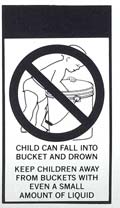
Courtesy of Coalition for Container Safety
|
As the new Federal emphasis (PL 99-457) on early intervention services for young children with disabilities evolves, and as programs for infants and toddlers are developed, the need to understand liability risks associated with working with these populations warrants attention. One of the key concerns of many early intervention programs is container safety.
Traditionally, professional training pertaining to water safety has focused on swimming pool settings. An early intervention program developed to address water safety is the American Red Cross (ARC) Infant and Preschool Aquatic Program. The Red Cross developed this program to promote swimming readiness skills, as well as water safety for infants and children. However, the ARC does not assure drown-proofing and survival of young children. The ARC Parent's Guide to the program stresses that young children "cannot be expected to comprehend potentially dangerous situations or to rely on their skill development or judgement to save their own lives."
The Third National Injury Control Conference (April 22-25, 1991) sponsored by the U.S. Department of Health and Human Services concluded that the swimming pool is just one of the known water-based risk factors for young children. For example, lapse in adult supervision is also a cause of drownings which may occur in bathtubs, five-gallon plastic buckets, toilet bowls, or humidifiers.
Five-gallon plastic buckets have gained considerable national attention as a drowning hazard. DL Mary Jumbelic, a forensic pathologist in Peoria County, Illinois, discovered 12 infant bucket drownings between 1985-1989. The figure accounted for one-fourth of all infant drownings within that period. According to the U.S. Consumer Product Safety Commission (CPSC), buckets are a previously unrecognized source of accidental drowning, yet roughly 50 infants and toddlers drown in buckets each year (NY Times, 1/11/92). The large size and heavy, rigid plastic construction of some buckets coupled with the undeveloped coordination of infants and toddlers, prevent young children from removing themselves after peering into and falling head first into such containers (Journal of the American Medical Association, April 11, 1990). These large, heavy, five-gallon buckets are manufactured and used to transport industrial and commercial products. Drownings occur when these buckets are found in early intervention programs as mop containers, diaper pails, or containers for nushing broken toilets. These containers are usually 14 inches high with the rim just below the typical top-heavy child's upright center of gravity (Pediatrics, June, 1992).
In August, 1990, the Coalition for Container Safety and the CPSC announced a joint program to address the problem of infant, and toddler drownings. The Coalition provides a free brochure to the public which addresses the safety hazard of five-gallon buckets and self-adhesive warning labels for placement on the containers. (Call 1-800-BUCKET-5 for the brochure and labels).
More recently, the American Society for Testing Material (ASTM) and CPSC have been working with producers, commercial users, and ultimate consumer groups to agree upon a voluntary manufacturing labeling standard for the entire industry. According to CPSC, for any label to be effective, it must be noticed, read, and be sufficiently persuasive to alter human behavior. Therefore, warning labels alone may not be a sufficient measure to help reduce the number of bucketrelated drownings.
An injury prevention and counseling program even more active than the previous steps may be necessary. For example, Michelle Zajac, of the American Academy of Pediatrics, notes that the Academy's Committee on Injury and Poison Prevention has recently drafted a Safety Sheet on water hazards pertaining to infants and toddlers. The safety document contains information on bucket drownings and safety concepts which is hoped will prove useful to both parents and professionals.
Can the profession playa more active role in helping to prevent the drowning of infants and toddlers? We might petition Representative Cardiss Collins (D, IL) to reintroduce H.R. 4706 to the l03rd Congress this year. If passed, the bill would establish a federal standard requiring labeling of all five-gallon buckets. As an additional safety measure, we might also ask that Collins' bill require that a guard or shield be attached to the top Qf all five-gallon containers. On a more local level, has your school/program established measures to identify water hazards used in infant and toddler programs, (e.g., toilet bowls and diaper pails)? Are these potential hazards labeled or, better yet, locked up when not in use?